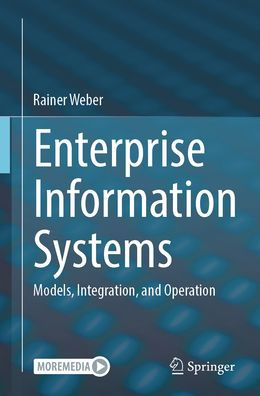The book is structured in three parts. “System Models” deals with the two types of enterprise information systems, transactional and analytical systems. It also introduces the various platforms, ranging from the "classic" three-tier client-server architecture to newer developments like in-memory computing, and discusses deployment options like pairs on-premises and cloud on the one hand, and monolithic systems and microservices on the other. Next, “Integration” deals with technical aspects for the combination of several enterprise information systems, describing a variety of techniques: integration via the user interface, through data exchange, through message brokers and Web services, or via process management systems. Eventually “Operations” covers topics related to the whole system lifecycle from selection and implementation to access control and administration.
The book is primarily aimed at bachelor students in information systems, who deal with the architecture of enterprise information systems. It can also be used by practitioners in industry for either self-study or to gain insight into information systems. To illustrate concepts, realizations in selected enterprise information systems such as SAP, Microsoft Dynamics 365 Business Central, Vtiger CRM and Pentaho are described.
The book is structured in three parts. “System Models” deals with the two types of enterprise information systems, transactional and analytical systems. It also introduces the various platforms, ranging from the "classic" three-tier client-server architecture to newer developments like in-memory computing, and discusses deployment options like pairs on-premises and cloud on the one hand, and monolithic systems and microservices on the other. Next, “Integration” deals with technical aspects for the combination of several enterprise information systems, describing a variety of techniques: integration via the user interface, through data exchange, through message brokers and Web services, or via process management systems. Eventually “Operations” covers topics related to the whole system lifecycle from selection and implementation to access control and administration.
The book is primarily aimed at bachelor students in information systems, who deal with the architecture of enterprise information systems. It can also be used by practitioners in industry for either self-study or to gain insight into information systems. To illustrate concepts, realizations in selected enterprise information systems such as SAP, Microsoft Dynamics 365 Business Central, Vtiger CRM and Pentaho are described.

Enterprise Information Systems: Models, Integration, and Operation
319
Enterprise Information Systems: Models, Integration, and Operation
319Paperback

Product Details
| ISBN-13: | 9783662717172 |
|---|---|
| Publisher: | Springer Berlin Heidelberg |
| Publication date: | 12/04/2025 |
| Pages: | 319 |
| Product dimensions: | 6.10(w) x 9.25(h) x (d) |
